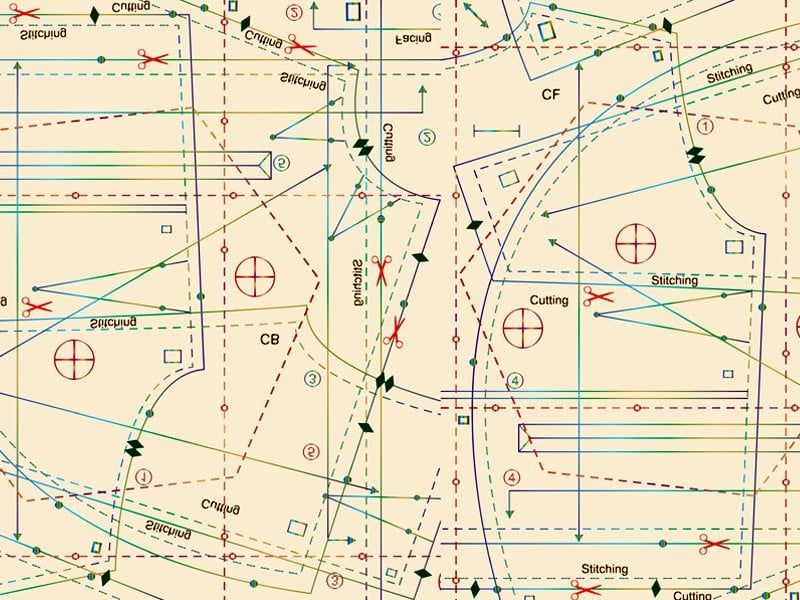
Most recently, I visited my tailor to have a banarsi lengha stitched for my brother’s wedding. I wanted to look absolutely stunning and after much planning, designing, matching and colour coordination, I handed it over. Fast forward four weeks and there I was at my tailor’s yet again, fighting back my tears. Not only was my lengha ruined, there was also not enough time to alter or find something else to wear. I had to resort to my mother’s old outfit to make do!

Whether it was delivering an outfit on time or stitching it differently from what we had wanted, every woman has suffered at the hands of her tailor for a great deal. And what’s worse is that every tailor has the same excuses! The words “Jee baaji, waqt per tayyaar hojaaye ga” simply hold no weight anymore.
One of the first and foremost excuses tailors have to offer — perhaps due to the complimenting circumstances around them — is that “Baaji, light nahin thi.” With rampant load-shedding across the country on their side, tailors have made it their go-to excuse for failure to deliver an outfit on time. And can you really blame them for it? No. After all, lack of electricity is indeed a valid reason. So you swallow your anger and accept your tailor’s alibi until you notice the myriad of finished dresses — ironed and ready — in the surrounding shops. Wait a minute! Dont sewing machines work manually and not with an electric pedal?
While load-shedding may be a relatively plausible excuse, inadequate material is not. Any woman who has ever been to a tailor will understand the sheer agony experienced when you find panels on your new dress or random jors on the sleeves and the words “Kapra kum par gaya thaa” ringing in your ears. According a Karachi-based university student Sidrah Waleed, “No matter how much material you give, tailors will always offer the same reason for putting a patch in your new kameez. Not to mention, even when you know that you gave more material than necessary, tailors always use up every last inch. I bet they hide the remaining cloth and save it for their wives and daughters.”
A common complaint amongst women is regarding tailors who think themselves to be fashion designers and often edit their outfits according to their own ideas. “My previous tailor used to forget all the instructions I would give him,” says Sana Naveen from Karachi. “He’d make the sleeves long when I asked for sleeveless or attach the lace in the wrong place. Once, he even dyed the dupatta another colour because he thought it would look better than the yellow I had chosen. I was so upset,” she adds. Perhaps this is a ploy to cover a mistake or two but it is downright frustrating when tailors change your outfit deliberately. “This is what happens when they take on too much work and don’t pay attention to the customer’s orders,” says Lahore-based homemaker Yasmeen Akhtar. “Personally, I think it is wrong that they customise someone else’s outfit according to their tastes. They should do what they are asked to.”

Rubina Akhtar* from Lahore has been stitching clothes for herself and her daughter at home for nearly 35 years as dealing with stubborn tailors is not her cup of tea. “It saves me so much time and energy,” she says, laughing. “Why would I want to go over and fight with tailors every day when I can make my dresses myself and modify them as I want?” Rubina advises women to try on their outfits and checking for faults at the tailor’s, before paying and heading home. “Hold the payment until all alterations are completed, otherwise they will never get done.”
Unfortunately, most of the above-mentioned scenarios happen only if the tailor has bothered to work on your outfit in the first place! With customer demands at an all time high, more and more women nowadays face rejection from tailors who refuse to accept their orders due to the backlog of work, particularly closer to Eid and the summer/winter wedding seasons. With so much workload, chances are that the gorgeous new suit you are looking so forward to is going to end up on the back of a shelf, rolled up in a ball and forgotten. Some tailors may push your order up for extra money but rarely will an outfit stitched in such a hurry turn out to be right. To avoid inconvenience and disappointment, it is best if one has their clothes made well in advance.
When speaking about tailors, it is impossible for one to overlook the rising prices they ask for in repayment for their work. If you are having a fancy jora made, be ready to pay around Rs2,000 to Rs3,000 just for stitching. “For one simple kameez, my tailor asks for a minimum of Rs1, 000,” says Islamabad-based housewife Maira Noman. “I can’t imagine how much money working women spend on stitching. They need larger wardrobes and perfect matching, ahead of the latest fashions,” she wonders. But Aliya Khan, a full-time employee at a call centre in Islamabad, has found a cheaper and more convenient alternative: ready-made clothing. “I am sick and tired of tailoring blunders, excuses and soaring prices of kapray,” complains Aliya. “Instead of running after dyers, tailors, lace-waalay etc, I just purchase ready-made outfits from local stores. They save a lot of time and hassle, especially for working women like me.” Many like Faisalabad’s Ayesha Ahmad have devised creative solutions to counter the sky-rocketing prices. “My maid’s sister is a darzan,” shares Ayesha. “I get my regular, everyday home-wear stitched by her for cheap. And occasionally, when I need to have a formal outfit done, I go to a proper tailor.”
One might argue that owing to the rising prices and trend and convenience of ready-made clothes, fewer women are now seeking tailoring than ever before — especially in big cities. Ashfaq Zahid, a middle-aged tailor with over 15 years of experience, defends his community when asked about the dying trend. “I can understand why women would not want to pay so much for one outfit,” he confesses. “But we are people too. We have our own set of problems. Inflation affects us more than it affects most of our customers but no one seems to realise that. I wish people would understand not all of us are liars and cheats.”
In contrast, there are some like Attock-based housewife Warda Ahsan who have never come across a badly-stitched outfit or a problematic tailor. Believe it or not, Warda says “Tailors are a blessing for women like me who don’t know how to sew or have access to ready-made clothing boutiques.” Lahore-based Alina Taj agrees. “So many women pick fights over the most trivial of mistakes,” she says. “I have heard some say horrendous things to their tailors in anger. It is no wonder these tailors are retaliating by refusing to work properly!”
Perhaps Warda and Alina aren’t wrong. “I think women should find one good tailor and nurture her relations with him,” suggests Alina. “Most tailors will favour the customer who gives them most business. Stick to one and they are likely to help you out whenever they can.”
Published in The Express Tribune, Ms T, March 2nd, 2014.
COMMENTS (3)
Comments are moderated and generally will be posted if they are on-topic and not abusive.
For more information, please see our Comments FAQ



1736167525-0/Untitled-design-(7)1736167525-0-165x106.webp)



















Yes Maeda, I agree to the fact that learning the art of stitching saves a lot of hassle, not to forget the in dependency that comes handy during shadi season and at Eids.
my luck, my grand mother was very strict ab8 this that girls shud learn stitching... atleast up to the extent that they can stitch their own dress... so she started to teach me in the age of 12... n I was also very ambitious as when I was just 8 years old...I started to use manual sewing machine to stitch my doll's out fits...n when I was 9 ...I started to use motorized sewing machine... I suggest girls that do excel in ur career n education but also learn basic house hold chores including stitching side by side... this is our actual field ...no matter whatever we learn... in whatever we excel... our final destination is our home....
Oh, yes. who has n't suffered in the hands of tailors... but men barely have such a problem.Its always the women who have such problems with tailors.